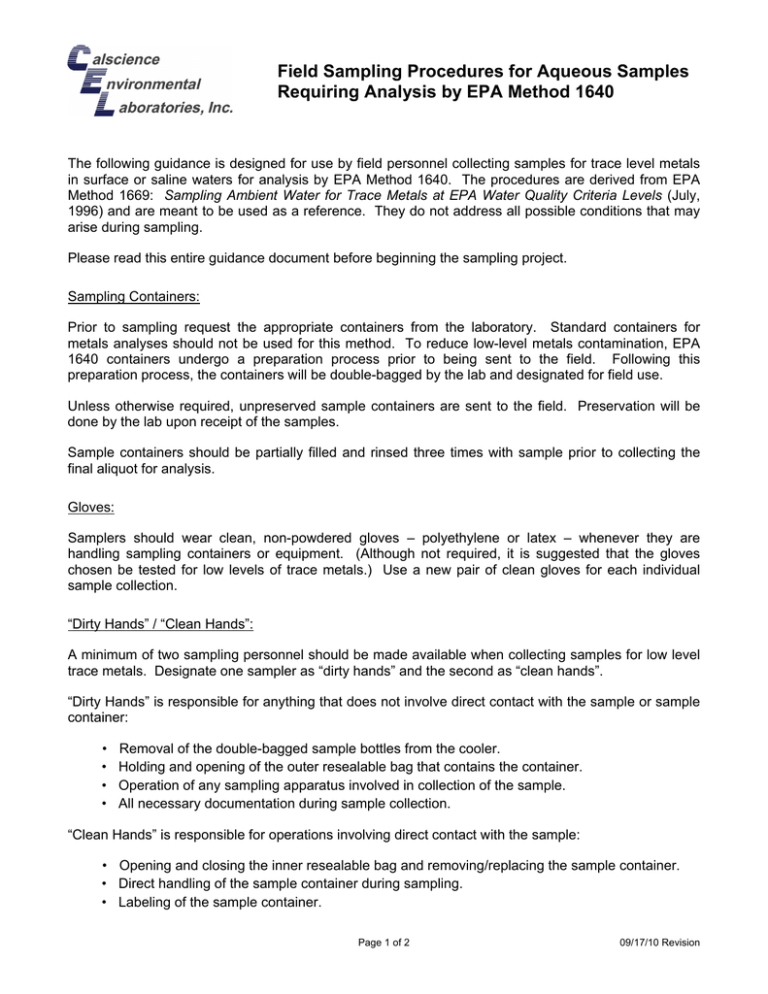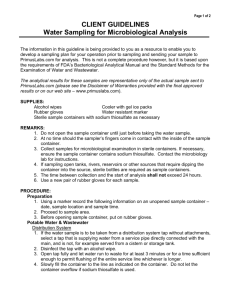Field Sampling Procedures for Aqueous Samples
advertisement

Field Sampling Procedures for Aqueous Samples Requiring Analysis by EPA Method 1640 The following guidance is designed for use by field personnel collecting samples for trace level metals in surface or saline waters for analysis by EPA Method 1640. The procedures are derived from EPA Method 1669: Sampling Ambient Water for Trace Metals at EPA Water Quality Criteria Levels (July, 1996) and are meant to be used as a reference. They do not address all possible conditions that may arise during sampling. Please read this entire guidance document before beginning the sampling project. Sampling Containers: Prior to sampling request the appropriate containers from the laboratory. Standard containers for metals analyses should not be used for this method. To reduce low-level metals contamination, EPA 1640 containers undergo a preparation process prior to being sent to the field. Following this preparation process, the containers will be double-bagged by the lab and designated for field use. Unless otherwise required, unpreserved sample containers are sent to the field. Preservation will be done by the lab upon receipt of the samples. Sample containers should be partially filled and rinsed three times with sample prior to collecting the final aliquot for analysis. Gloves: Samplers should wear clean, non-powdered gloves – polyethylene or latex – whenever they are handling sampling containers or equipment. (Although not required, it is suggested that the gloves chosen be tested for low levels of trace metals.) Use a new pair of clean gloves for each individual sample collection. “Dirty Hands” / “Clean Hands”: A minimum of two sampling personnel should be made available when collecting samples for low level trace metals. Designate one sampler as “dirty hands” and the second as “clean hands”. “Dirty Hands” is responsible for anything that does not involve direct contact with the sample or sample container: • • • • Removal of the double-bagged sample bottles from the cooler. Holding and opening of the outer resealable bag that contains the container. Operation of any sampling apparatus involved in collection of the sample. All necessary documentation during sample collection. “Clean Hands” is responsible for operations involving direct contact with the sample: • Opening and closing the inner resealable bag and removing/replacing the sample container. • Direct handling of the sample container during sampling. • Labeling of the sample container. Page 1 of 2 09/17/10 Revision Field Sampling Procedures for Aqueous Samples Requiring Analysis by EPA Method 1640 Sampling: When ready to sample, “dirty hands” should remove the double-bagged sample containers from the cooler and open the exterior resealable bag allowing clear access to the inner bag. “Clean hands” should open the inner resealable bag and remove the sample container, being sure to reclose the inner bag after removal to limit the potential for contamination. If collecting an aqueous “grab” sample from an open source rapidly submerge the entire unpreserved container, filling and capping the container while still submersed in order to minimize exposure to airborne contamination. Be sure that the container is completely filled (no headspace). Again, prior to its final filling, the sample container should be partially filled with sample and rinsed 3 times. Apply the sample label to the container. If preserved containers are required for sample collection, do not rinse the container prior to sample collection and do not completely submerge the container during sampling. To collect the sample you may gently tip the top of the container below the water surface until completely filled. This will allow the preservative to remain in the container. You may also use a clean, unpreserved container that has been rinsed three times with the sample, as an intermediate collection device, transferring the final aliquot to the preserved container. Following sample collection, “dirty hands” should hold open the outer resealable bag while “clean hands” will open the inner bag, return the container and then seal the inner bag. “Dirty hands” can then seal the outer bag and return the sample to the cooler. If custody seals are required for the samples, “dirty hands” will place the seal over the opening of the outer resealable bag prior to placing in the cooler. Do not place the seal on the inner bag or actual sample container. If field blanks are to be collected, an additional bottle of reagent water can be supplied by the lab. To create a field blank, rinse a sample container three times with the reagent water and then fill completely with a final aliquot of the reagent water and cap. This process should be done at the same time as and in the same sampling location as the actual field samples and the field blank should be handles in the same manner as the samples. Shipping: Samples are to be maintained at 0~4°C until lab preservation. Pack the samples in wet ice or refrigerate immediately following collection. During shipping, the samples must be packed in a sufficient amount of wet ice to maintain an acceptable temperature range. If the samples require filtration for dissolved metals analysis, they must be filtered within 2 days of sample collection and be kept at 0~4°C prior to filtration. If field filtering is not an option, the samples must be sent to the laboratory as soon as possible to allow for filtration and preservation within 2 days of sample collection. Page 2 of 2 09/17/10 Revision





